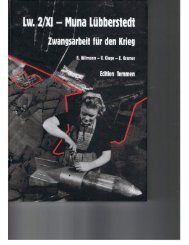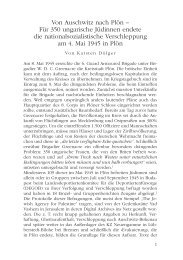The Kallos Family Book 2022
Always remember and tell the story to the world
Always remember and tell the story to the world
- TAGS
- barbara lorber
You also want an ePaper? Increase the reach of your titles
YUMPU automatically turns print PDFs into web optimized ePapers that Google loves.
INTRODUCTION • 3
Famous since the 1870s for its apples,
Ťačovo was known as the apple orchard capital
of Czechoslovakia. People believed it was the
water irrigated from the Tisa River that made
the apples extra sweet. Crops such as wheat,
corn, tobacco, sugar beet and potatoes thrived
in the area’s fertile soil. Vineyards, orchards and
walnut groves were cultivated in the nearby
Carpathian foothills; the area also had a successful
lumber industry. Sheep and cattle farms
and livestock bazaars in Ťačovo’s market square
provided income for some families, as did the
springtime fruit fairs held in the town’s centre.
Several hotels in the town accommodated
the many tourists and businessmen who passed
through. Barbara’s Kallos’ family owned one
such hotel, the Kallos Hotel.
Ťačovo’s ethnic groups
Ťačovo was multi-ethnic and multilingual.
According to the 1930 Czech census, Ťačovo had
a population of 7,417 made up of Ruthenians
(the largest group), Hungarians (31 per cent),
Jews (20 per cent) and small numbers of other
nationalities such as Czechs and Romanians.
The Ruthenians in Ťačovo, today called
Ukrainians, are east Slavic highlanders, the
indigenous people of the area, after whom the
Czech province of Sub Carpathian Ruthenia is
named. The Carpathian Mountains were their
historical homeland.
The reason there were so many Hungarians
in Ťačovo was because before the outbreak of
World War 1, this area had been inhabited and
ruled by Hungarians for centuries. Then, in
1939, as Germany’s allies, Hungary reoccupied
the area.
The high number of Jews in Ťačovo was
because centuries before many Jews fled to the
area from nearby Polish Galicia and its 1650s
pogroms. Later, they were also attracted to the
comparatively liberal attitude of the then ruling
Hungarians towards Jews.
The Jewish community
of Ťačovo
The Jewish community of Ťačovo was the
centre for more than thirty small regional
Jewish communities. Its substantial Orthodox
community attended the Great Synagogue on
Hlavní ulica and the study house next door.
There were several cheders (kindergarten /
primary school instruction for boys only, that
taught the basics of Judaism and the Hebrew
language), a Bais Yaakov school of Jewish
education for girls, a Jewish cemetery, chevra
kadisha (funeral society), mikvah (ritual bath),
shochet (ritual slaughterer), Yeshiva (an orthodox
Jewish college or seminary, only for boys)
and other religious and social organisations.
Jewish charitable organisations provided services
such as clothing, household help for new
mothers, bikur cholim (visiting and aid for the
sick) and a soup kitchen for the poor. Chassidic
Jews also lived in Ťačovo where they followed
their various tenets with their Rebbes (spiritual
leaders). They prayed and studied in their own
prayer house and study halls, and at times in
private homes.
Members of Ťačovo’s rapidly growing Zionist
movement taught Hebrew to prepare young Jews
for Aliya (emigration to Palestine). Zionist youth
organisations such as the right wing revisionist
Betar and the socialist left wing Hashomer
Hatzair (Young Guard) were active and influential
in Ťačovo. The many children who belonged
to these organisations participated in the organisations’
weekend activities.





